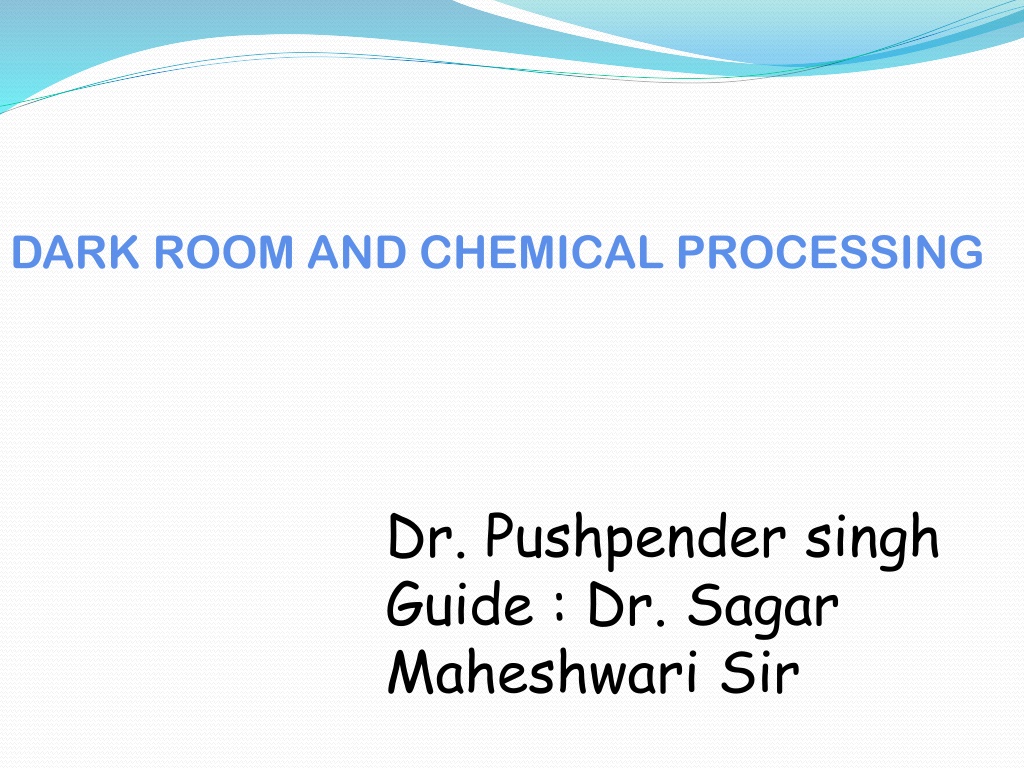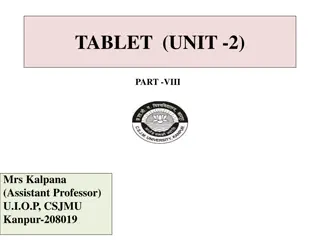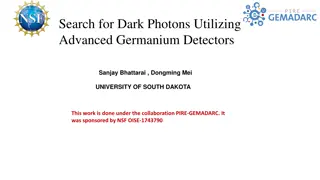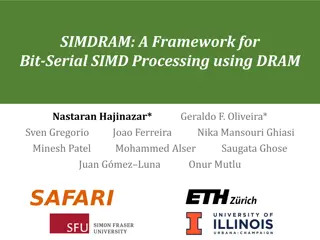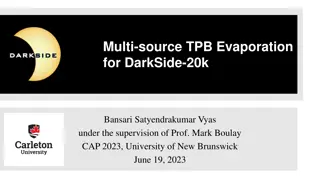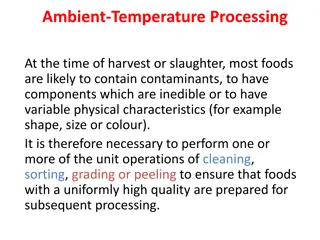Setting Up a Dark Room for Safe and Efficient Film Processing
A dark room is essential for handling and processing film without the risk of fog due to light exposure. Learn about the wet and dry sides of the darkroom, equipment needed, design considerations, and lead shielding requirements if adjacent to an X-ray room.
Download Presentation

Please find below an Image/Link to download the presentation.
The content on the website is provided AS IS for your information and personal use only. It may not be sold, licensed, or shared on other websites without obtaining consent from the author. Download presentation by click this link. If you encounter any issues during the download, it is possible that the publisher has removed the file from their server.
E N D
Presentation Transcript
DARK ROOM AND CHEMICAL PROCESSING Dr. Pushpender singh Guide : Dr. Sagar Maheshwari Sir
DARKROOM A darkroom is a place where the necessary handling and processing of film can be carried out safely and efficiently, without the hazard of producing film fog by accidental exposure to light rays.
DARK ROOM Dark room is more accurately known as the Processing Room . It forms a very important part of radiography, such that radiography begins and ends here. It has two sides: wet side Dry side *film handling * loading * unloading * Processing - Manual - automatic 3
DRY SIDE OF DARK ROOM The shelves: For storing the films and film boxes. They should be away from tanks containing chemicals and from the entrance, preferably behind the door. The film boxes should be set vertically, not one over the other. Pass Box: To transfer the films Other apparatus like- Light proof storage bin for unexposed film Drying devices Film hangers of proper size 4
WET SIDE OF DARK ROOM Processing tanks It has ready mixed processing chemicals. Two stirring paddles one each for developer and fixer. Thermometer to determine temperature of the solutions. 5
LOCATION Decided during planning of the department. Convenient placement in relation to radiographic room No windows to make the room light proof. Readily accessible to plumbing and electric service. 7
SIZE OF THE DARKROOM It should be smaller than 9 msq.in area. The ceiling should not be less than 2.7m in height and preferably not more than 3.3m
LEAD SHIELDING IF ADJACENT TO X-RAY ROOM Walls b/w the darkroom and adjoining x-ray rooms should contain enough lead thickness of atleast 1.6mm(1/16 inch) of lead in the walls all the way to the ceiling.
ENTRANCE Light proof, to prevent light exposure to the film. Two way revolving door type is the ideal type in which two cylinders are present. The outer cylinder has two entry gates in it on opposite sides and the inner one has one gate. 10
REVOLVING DOOR- Advantage is it does not require a large floor area.
MAZE or LABYRINTH TYPE- dis adv- occupies a large floor area.
DARK ROOM EQUIPMENT Dark room has the following.:- Cassette hatches Film hangers Light proof storage bins Safelight Processing tanks Drying devices
LIGHT PROOF STORAGE BINS It is used to store Unused films. Vertical partitions Subdivide the bin to Accommodate film Boxes of different sizes.
SAFELIGHT Provides adequate illumination under processing condition but does not fog the film.
HOW DOES A SAFE LIGHT WORK.. When a white light is passed through colored filters , certain wavelengths(or colors )are absorbed by the filters, whilst those wavelengths which correspond to the color of the filters will be transmitted.
SAFELIGHT HAS THREE BASIC PARTS Lamp housing:- This holds the bulb and filter. Safelight filter:- This absorbs light of some colors and transmits light of others to varying degrees. The bulb:- 25 W pearl lamp is the recommended standard.
SAFELIGHT FILTERS.. It consists of a gelatin dyed to the appropriate color and sandwiched between two sheets of glass for protection.
TYPES OF SAFE LIGHTING.. Direct safe lighting:- light from the safe lamp falls directly onto the work surface. Such illumination should be sited a minimum distance of 1.2 m (4ft) from the working surface. It is the best lighting for film loading and unloading areas.
INDIRECT LIGHTING.. It is intended to provide general illumination of the darkroom. The safe lamp directs the light towards ceiling, which consequently should be painted in light color in order to reflect light back into the room.
RED FILTER-- KODAK GBX-2 for most blue and green sensitive medical and dental x-ray films.
FACTS ABOUT SAFE LIGHT.. No safe light provides completely safe exposure for an indefinite period of time. Safelight filters are designed for specific types of paper and film. Safelight filters fade with use. Poor safelight conditions can produce a loss in radiographic quality before actual fogging is visible
INTENSITY OF THE UNDESIRABLE WAVELENGTHS TRANSMITTED BY THE FILTER IS INCREASED BY.. Using too small a safelight to film distance(intensity increased due to inverse square law) Using too high a wattage lamp inside the safe light(a 25 W pearl lamp sited a minimum of 1.2m from the film is the recommended standard)
HOW SAFE IS SAFE LIGHTING? Safe lighting is not completely safe; as all films will become significantly fogged if exposed to safe light for long time. This is because safelight filters are not perfect absorbers of the undesirable wavelengths. So the intensity of illumination and film handling should be kept to a minimum if significant fogging is to be prevented.
SAFE FILM HANDLING TIME. Safe film handling time is defined as the maximum time for which a film can be exposed to the safelights during the procedure without causing any appreciable degree of fogging.
EQUIPMENT REPAIR AND DARKROOM CLEANING
Stages in production of radiograph Exposure Development Wash Fixing Washing Dry
Types of processing: Manual Automatic : with replenisher without replenisher
Differences between manual and automatic processing No stop bath between developer and fixer Hardner is placed in developer Additional hardner is added to fixer solution Dark room is not required Automated processor is used in form of processing rollers hence dry to dry process.
MANUAL PROCESSING TANKS The simplest type has three compartment tank One end compartment being used for developing and the opposite one for fixing. The middle compartment serves both to rinse and wash the films and should be supplied with running water.
SIZE OF MANUAL PROCESSING TANK 3 PARTS Development Tank Fixing tank Washing tank 2 4 1 The ratio of size of tanks is 1:2:4 33
MANUAL PROCESSING TANK It is insulated outside to prevent condensation of water and to maintain temp inside. Thermostatically controlled warm or refrigerated water (depending on the weather) should be circulated around the processing tank to maintain optimum temp.
Film Base Supports the emulsion and provides the correct degree of stiffness for handling purposes. It is composed of either cellulose acetate or polyester, both of which are transparent and blue- tinted. (1) Cellulose acetate Dissolving cotton in acetic acid makes cellulose acetate which is then dissolved in a volatile solvent containing blue dye. The solution of cellulose acetate is poured onto huge heated drums where it solidifies to a thickness of about 0.008 inch.
(2) Polyester. The dimethyl-terebthalate (DMT) DMT + ETYLENE GLYCOL POLYSTER ADV OF POLYESTER 1 increased dimensional stability 2 much stronger than acetate
EMULSION Formed by silver bromide and gelatin Silver bromide crystal. In the early stages of emulsion manufacturing, silver nitrate +potassium bromide silver bromide crystals + potassium nitrate. The potassium nitrate is then washed out and the result is a silver bromide crystal consisting of bound atoms of silver and bromide. In medical film 90 - 99 % - AgBr 1 - 10 % - AgI Crystal size of silver halide 1 1.5 microns
REMOVAL OF FILM FROM CARTON Always remove the film slowly. Rapid movement can cause a build-up of static electricity. Careful handling will prevent many kinds of marks on the film LOADING The film is placed in the bottom of the cassette on the front intensifying screen. The lid carrying the back screen is gently closed and locked by means of the back springs. Avoid scraping or sliding the film over the edges of the cassettes or the surface of the screen.
HANDLING and STORAGE OF XRAY FILMS Unexposed and unprocessed x-ray film should always be kept in a cool, dry place. It should never be stored in basements or near steam pipes or other sources of heat. High temperatures damage the emulsion, causing fog and lack of contrast Ideal storage conditions prevail at temperatures of 50 to 75 F with relative humidity of 40 to 60 percent
PRESSURE Should never be subjected to extreme pressure such as wrinkling, bending, or rolling, because changes take place in the emulsion, which, upon development, appear as tree- like artefacts on the finished film. To avoid pressure markings, packages of unexposed film should always be stored on edge; they should never be stacked one upon another. All film should be used before its expiration date
PRODUCTION OF THE LATENT IMAGE When the x-ray film emulsion is sensitized during manufacture, the SILVER BROMIDE crystals are left in a state of suspended animation awaiting the x-ray stimulus to start them on their way to becoming a radiographic image. The potentiality for this activity exists in the tiny sensitization "specks" at the surface of the crystal which are actually SILVER SULFIDE coumpound When x-ray exposure occurs, the latent image is produced.
AgBr + silver sulphide ( sensitivity speck) When exposure of film to light from intensifying Screen or to direct action of x ray , energy from photon is trapped by BROMIDE ION BROMIDE ION loose electron Br ion + photon Br atom + electron
Electron trapped by silver sulphide Which become negatively charged Attracts Ag ion and give electrons to them Ag ion + electron Ag atom This process is repeated many times Crystal in which sensitivity specks has acquired Ag atoms during exposure remain invisible and constitute LATENT IMAGE
CHEMICAL DEVELOPER CONTAINS PHENIDONE HYDROQUINONE ACCELERATOR BUFFER AGENT PRESERVATIVES RESTRAINERS HARDENERS SEQUESTERING AGENT FUNGICIDE ANTI FROTHANT
DEVELOPER ACTIVITY DEPENDS UPON PH TEMPERATURE EVAPORATION OXIDATION PROCESSING BYPRODUCTS (BROMIDE)
DEVELOPEMENT Process that amplifies the latent image by a factor of millions to form a visible silver pattern . Activator The activator (or alkali), SODIUM CARBONATE, softens the gelatin And provides the necessary alkaline medium so that the reducing agents can diffuse into the emulsion and attack the exposed silver bromide crystals. Other alkalies used are SODIUM HYDROXIDE , SODIUM TETRABORATE In general, the more alkaline the developer, the more powerful and rapid is its action.
DISADVANTAGE OF SODIUM CARBONATE When a film is processed in an x-ray developer containing it and then transferred to a warm acid-fixing bath, tiny bubbles of carbon dioxide gas may form in the soft gelatin. As the bubbles escape, they form tiny craters or pits in the emulsion, thereby breaking up the normal character of the silver image. The finished film or radiograph is blistered. To overcome this effect, the temperature of the developer, rinse, and fixer solutions should be approximately the same.
Reducers The latent image site provides a place where the reducers accomplish the process of breaking down the silver bromide crystal to black metallic silver. The reducing agents act as electron donors to the latent image site. Thus the positively charged silver ions may move into the areas of the sensitivity speck and become attracted to it. As this process continues, more silver ions are attracted and deposited as atoms of silver. The final result is the formation of black silver crystal
Reducing agents ElonTM (another tradename is MetolTM) and hydroquinone. The activity of these chemicals requires their presence in an alkaline solution. ElonTM is unpredictable above 75 F and hydroquinone ceases its activity below 60 F. The activity of the hydroquinone is slower, but it serves to build up the black tones required in the image. Reducers are not too stable in the presence of oxygen, which they can readily absorb from the air , hence developer should always be kept covered.
Basic chemical reaction in development process DEVELOPER (HYDROQUINONE) + SILVER ION alkaline solution OXIDISED DEVELOPER (quinone) + SILVER ATOM + HYDROGEN ION
